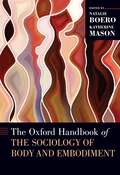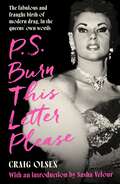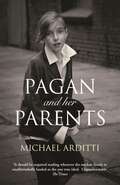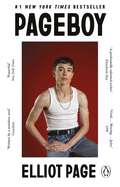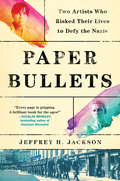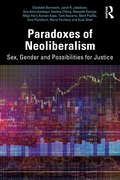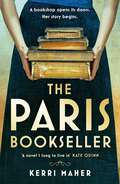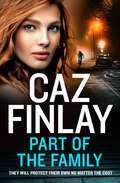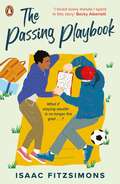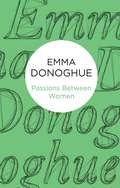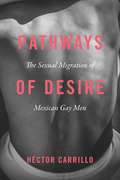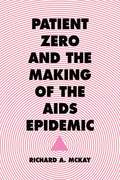- Table View
- List View
The Oxford Handbook of the Sociology of Body and Embodiment (Oxford Handbooks)
by Katherine Mason Natalie BoeroIn popular debates over the influences of nature versus culture on human lives, bodies are often assigned to the category of "nature": biological, essential, and pre-social. The Oxford Handbook of the Sociology of Body and Embodiment challenges that view, arguing that bodies both shape and get shaped by human societies. As such, the body is an appropriate and necessary area of study for sociologists. The Handbook works to clarify the scope of this topic and display the innovations of research within the field. The volume is divided into three main parts: Bodies and Methodology; Marginalized Bodies; and Embodied Sociology. Sociologists contributing to the first two parts focus on the body and the ways it is given meaning, regulated, and subjected to legal and medical oversight in a variety of social contexts (particularly when the body in question violates norms for how a culture believes bodies "ought" to behave or appear). Sociologists contributing to the last part use the bodily as a lens through which to study social institutions and experiences. These social settings range from personal decisions about medical treatment to programs for teaching police recruits how to use physical force, from social movement tactics to countries' understandings of race and national identity. The Oxford Handbook of the Sociology of the Body also prioritizes empirical evidence and methodological rigor, attending to the ways particular lives are lived in particular physical bodies located within particular cultural and institutional contexts. Many chapters offer extended methodological reflections, providing guidance on how to conduct sociological research on the body and, at times, acknowledging the role the authors' own bodies play in developing their knowledge of the research subject.
The Oxford Handbook of the Sociology of Body and Embodiment (Oxford Handbooks)
In popular debates over the influences of nature versus culture on human lives, bodies are often assigned to the category of "nature": biological, essential, and pre-social. The Oxford Handbook of the Sociology of Body and Embodiment challenges that view, arguing that bodies both shape and get shaped by human societies. As such, the body is an appropriate and necessary area of study for sociologists. The Handbook works to clarify the scope of this topic and display the innovations of research within the field. The volume is divided into three main parts: Bodies and Methodology; Marginalized Bodies; and Embodied Sociology. Sociologists contributing to the first two parts focus on the body and the ways it is given meaning, regulated, and subjected to legal and medical oversight in a variety of social contexts (particularly when the body in question violates norms for how a culture believes bodies "ought" to behave or appear). Sociologists contributing to the last part use the bodily as a lens through which to study social institutions and experiences. These social settings range from personal decisions about medical treatment to programs for teaching police recruits how to use physical force, from social movement tactics to countries' understandings of race and national identity. The Oxford Handbook of the Sociology of the Body also prioritizes empirical evidence and methodological rigor, attending to the ways particular lives are lived in particular physical bodies located within particular cultural and institutional contexts. Many chapters offer extended methodological reflections, providing guidance on how to conduct sociological research on the body and, at times, acknowledging the role the authors' own bodies play in developing their knowledge of the research subject.
P.S. Burn This Letter Please: The fabulous and fraught birth of modern drag, in the queens' own words
by Craig OlsenWith an introduction from RuPaul's Drag Race winner Sasha VelourTheir greatest act of resistance was simply existing In 1950s New York, a group of drag pioneers found work in a small number of Lower East Side clubs. They occupied the margins of society, determined to live authentically, despite the attentions of the police. These girls were unstoppable, fearless and fabulous, but their very existence was deemed a criminal threat to society.When a secret cache of their letters was discovered in 2014, these individuals were given a voice for the first time. The letters reveal personal triumphs and tragedies, and a fascinating world that has rarely been documented.Expertly weaving social, political and cultural history, Craig Olsen illuminates the lives and loves of our exceptional LGBTQ+ forebears.P.S. Burn This Letter Please is the ground-breaking result: a deeply moving encounter with a generation of survivors, and a necessary account of how modern drag culture was born.
Pagan and Her Parents
by Michael ArdittiA powerful novel about a gay man's struggle to adopt the daughter of his late best friend'Unputdownable' The Times'Arditti writes exactly like Dickens' Scotland on Sunday'I honestly couldn't put the book down' Literary ReviewCandida Mulliner and Leo Young have been the closest of friends since university, living together but loving separately. When Candida dies after a long illness, she leaves her five year old daughter, Pagan, in Leo's care. Candida's adoptive parents are horrified; they refuse to accept that a single man is a suitable person to bring up a child and challenge Leo's guardianship in the courts. The ensuing hearings are complicated by tabloid exposure of Leo's homosexuality, which threatens not only his position with Pagan but also his job as a television chat-show host. As Leo fights for his and Pagan's rights in a society that continues to regard gay men as a threat to children, he finds himself isolated, vilified and, ultimately, arrested. Meanwhile, he endeavours to discover the truth about Candida, the cause of her estrangement from her adoptive parents, the identity of her natural mother and the reason for her refusal to name Pagan's father.
Pageboy: A Memoir: The Instant Sunday Times Bestseller
by Elliot Page#1 NEW YORK TIMES BESTSELLERINSTANT SUNDAY TIMES BESTSELLER'Singular' Daily Telegraph'Powerful' New York Times'Vital' i'Vivid… Moving… Juicy' NPR'A profoundly talented writer' Elizabeth Day'Raw, harrowing, and often heartbreaking' LA Times'Written by a sensitive soul' GuardianBefore the world premiere of Juno Elliot Page was on the edge of self-discovery. But with Juno's massive success and his dreams coming true, Elliot found himself trapped by the spotlight and the pressure to perform was suffocating him. Until enough was enough. From chasing down secret love affairs to battling body image and working through his difficult childhood, Pageboy is a beautiful, intimate book about searching for ourselves and our place in the world.'An emotional read, delivered in image-drenched prose.' Washington Post'The emergence of our true selves is all of our life's work. Pageboy helps chart the course.' Jamie Lee Curtis'Pageboy is like listening to a friend... Now is an excellent time to read this humanizing and well-written memoir.' Associated Press
Pages for Her: A Novel
by Sylvia Brownrigg'A complex portrait of two women's sexuality . . . an absolute pleasure' Alice SeboldFlannery, a writer with one well-known rather racy book to her name, is, by her own admission, in a situation she never thought she'd be: married to a man who overshadows her and defined by her primary relationships as wife and mother. When Flannery is invited to a writers' conference she sees a chance to return to a world she knew well. And then she recognizes the name of the chair of the event: Anne Arden. Suddenly Flannery is thrown back twenty years to her eighteen-year-old self and the most intense love affair of her entire life. On the other side of the world Anne is travelling for work. Recently out of a decades-long partnership, she feels adrift, unsettled. When a friend asks her to chair an event at a writers' conference she says yes and a couple of months later, on the same campus where they met and fell in love, Anne and Flannery are reunited. Though their lives have taken them in different and unexpected directions, the pull between them proves irresistible. Elegant, clever, witty and sensual, Sylvia Brownrigg's Pages for Her is a novel about love, memory and what it is to be a woman, a wife, and a mother.
Pages for You: A Novel
by Sylvia Brownrigg‘A love letter written for a lost lover . . . mesmerizing’ Helen Dunmore, The TimesWhen Flannery Jansen arrives at university, she is totally unprepared for an encounter that will rock her existence. But when she comes across Anne Arden in a local diner, Flannery falls dramatically and desperately in love. Flannery is quickly embarrassed in the face of the older woman’s poise and sophistication, and under the gaze of those impossible green eyes, but slowly their paths intertwine, and soon Flannery becomes Anne’s eager student in life and love.Pages for You is the story of the beginning, blossoming and falling apart of that delirious love affair.
Paper Bullets: Two Artists Who Risked Their Lives to Defy the Nazis
by Jeffrey H. Jackson&“A Nazi resistance story like none you&’ve ever heard or read.&” —Hampton Sides, author of Ghost Soldiers and On Desperate Ground"Every page is gripping, and the amount of new research is nothing short of mind-boggling. A brilliant book for the ages!&” —Douglas Brinkley, author of American Moonshot A Stonewall Honor Book in Nonfiction Longlisted for the Carnegie Medal for Excellence in NonfictionPaper Bullets is the first book to tell the history of an audacious anti-Nazi campaign undertaken by an unlikely pair: two French women, Lucy Schwob and Suzanne Malherbe, who drew on their skills as Parisian avant-garde artists to write and distribute &“paper bullets&”—wicked insults against Hitler, calls to rebel, and subversive fictional dialogues designed to demoralize Nazi troops occupying their adopted home on the British Channel Island of Jersey. Devising their own PSYOPS campaign, they slipped their notes into soldier&’s pockets or tucked them inside newsstand magazines. Hunted by the secret field police, Lucy and Suzanne were finally betrayed in 1944, when the Germans imprisoned them, and tried them in a court martial, sentencing them to death for their actions. Ultimately they survived, but even in jail, they continued to fight the Nazis by reaching out to other prisoners and spreading a message of hope. Better remembered today by their artist names, Claude Cahun and Marcel Moore, the couple&’s actions were even more courageous because of who they were: lesbian partners known for cross-dressing and creating the kind of gender-bending work that the Nazis would come to call &“degenerate art.&” In addition, Lucy was half Jewish, and they had communist affiliations in Paris, where they attended political rallies with Surrealists and socialized with artists like Gertrude Stein.Paper Bullets is a compelling World War II story that has not been told before, about the galvanizing power of art, and of resistance.
Paradoxes of Neoliberalism: Sex, Gender and Possibilities for Justice (Social Justice)
by Elizabeth Bernstein Janet R. JakobsenFrom the rise of far-right regimes to the tumult of the COVID-19 pandemic, recent years have brought global upheaval as well as the sedimentation of longstanding social inequalities. Analyzing the complexities of the current political moment in different geographic regions, this book addresses the paradoxical persistence of neoliberal policies and practices, in order to ground the pursuit of a more just world. Engaging theories of decoloniality, racial capitalism, queer materialism, and social reproduction, this book demonstrates the centrality of sexual politics to neoliberalism, including both social relations and statecraft. Drawing on ethnographic case studies, the authors show that gender and sexuality may be the site for policies like those pertaining to sex trafficking, which bundle together economics and changes to the structure of the state. In other instances, sexual politics are crucial components of policies on issues ranging from the growth of financial services to migration. Tracing the role of sexual politics across different localities and through different political domains, this book delineates the paradoxical assemblage that makes up contemporary neoliberal hegemony. In addition to exploring contemporary social relations of neoliberal governance, exploitation, domination, and exclusion, the authors also consider gender and sexuality as forces that have shaped myriad forms of community-based activism and resistance, including local efforts to pursue new forms of social change. By tracing neoliberal paradoxes across global sites, the book delineates the multiple dimensions of economic and cultural restructuring that have characterized neoliberal regimes and emergent activist responses to them. This innovative analysis of the relationship between gender justice and political economy will appeal to: interdisciplinary scholars in social and cultural studies; legal and political theorists; and the wide range of readers who are concerned with contemporary questions of social justice.
Paradoxes of Neoliberalism: Sex, Gender and Possibilities for Justice (Social Justice)
by Janet Jakobsen and Elizabeth BernsteinFrom the rise of far-right regimes to the tumult of the COVID-19 pandemic, recent years have brought global upheaval as well as the sedimentation of longstanding social inequalities. Analyzing the complexities of the current political moment in different geographic regions, this book addresses the paradoxical persistence of neoliberal policies and practices, in order to ground the pursuit of a more just world. Engaging theories of decoloniality, racial capitalism, queer materialism, and social reproduction, this book demonstrates the centrality of sexual politics to neoliberalism, including both social relations and statecraft. Drawing on ethnographic case studies, the authors show that gender and sexuality may be the site for policies like those pertaining to sex trafficking, which bundle together economics and changes to the structure of the state. In other instances, sexual politics are crucial components of policies on issues ranging from the growth of financial services to migration. Tracing the role of sexual politics across different localities and through different political domains, this book delineates the paradoxical assemblage that makes up contemporary neoliberal hegemony. In addition to exploring contemporary social relations of neoliberal governance, exploitation, domination, and exclusion, the authors also consider gender and sexuality as forces that have shaped myriad forms of community-based activism and resistance, including local efforts to pursue new forms of social change. By tracing neoliberal paradoxes across global sites, the book delineates the multiple dimensions of economic and cultural restructuring that have characterized neoliberal regimes and emergent activist responses to them. This innovative analysis of the relationship between gender justice and political economy will appeal to: interdisciplinary scholars in social and cultural studies; legal and political theorists; and the wide range of readers who are concerned with contemporary questions of social justice.
The Paris Bookseller
by Kerri MaherINSPIRED BY THE WOMAN WHO FOUNDED SHAKESPEARE AND COMPANY'A vivid evocation of the famous female-owned Parisian bookshop... Kerri Maher writes a love letter to books, bookstores and booklovers everywhere' Kate Quinn, author of The Alice Network'I was completely enthralled' Natasha Lester, author of The Paris SecretThe captivating story of a trailblazing young woman who fought against incredible odds to bring one of the most important books of the twentieth century to the world. For readers of The Paris Library and The Paris Wife.PARIS, 1919.Young, bookish Sylvia Beach knows there is no greater city in the world than Paris. But when she opens an English-language bookshop on the bohemian Left Bank, Sylvia can't yet know she is making history.Many leading writers of the day, from Ernest Hemingway to Gertrude Stein, consider Shakespeare and Company a second home. Here some of the most profound literary friendships blossom - and none more so than between James Joyce and Sylvia herself.When Joyce's controversial novel Ulysses is banned, Sylvia determines to publish it through Shakespeare and Company. But the success and notoriety of publishing the most infamous book of the century comes at deep personal cost as Sylvia risks ruin, reputation and her heart in the name of the life-changing power of books...---'A compelling and fascinating look at the world-changing mavericks who bonded, bickered and triumphed in the realm of literature' Nuala O'Connor'A compelling portrait of a remarkable woman, who steps from the pages in all her charm, courage and vulnerability' Gill Paul'Intelligent, fierce and filled with reverence for a fascinating epoch in literary history... a delight for readers and writers' Whitney Scharer, author of The Age of Light'Lulls you into an interwar Parisian dream where love - be it romantic, friendly or even for a book - can be found on a quirky little street in the 6th' Kaia Alderson, author of Sisters in Arms
Part of the Family (Bad Blood #6)
by Caz FinlayThe brand new gangland thriller from Queen of Liverpool crime, Caz Finlay
The Passing Playbook
by Isaac FitzsimonsLove, Simon meets Friday Night Lights in this feelgood LGBTQ+ romance about a trans teen torn between standing up for his rights and staying stealth.'A sharply observant and vividly drawn debut. I loved every minute I spent in this story' - Becky AlbertalliFifteen-year-old Spencer Harris is a proud nerd, an awesome big brother and a Messi-in-training. He's also transgender. After transitioning at his old school leads to a year of bullying, Spencer gets a fresh start at Oakley, the most liberal private school in Ohio. At Oakley, Spencer seems to have it all: more accepting classmates, a decent shot at a starting position on the boy's soccer team, great new friends, and maybe even something more than friendship with one of his teammates. The problem is, no one at Oakley knows Spencer is trans - he's passing. So when a discriminatory law forces Spencer's coach to bench him after he discovers the 'F' on Spencer's birth certificate, Spencer has to make a choice: cheer his team on from the sidelines or publicly fight for his right to play, even if it means coming out to everyone - including the guy he's falling for.
Passions Between Women: British Lesbian Culture, 1668-1801
by Emma DonoghuePassions Between Women looks at stories of lesbian desires, acts and identities from the Restoration to the beginning of the nineteenth century. Far from being invisible, the figure of the woman who felt passion for women in this period was a subject of confusion and contradiction: she could be put in a freak show as a 'hermaphrodite', denounced as a 'tribade' or 'lesbian', revered as a 'romantic friend', jailed as a 'female husband' or gossiped about as a 'woman-lover', 'tommy' or 'Sapphist'. Through an examination of a wealth of new medical, legal and erotic source material, together with re-readings of classics of English literature, Emma Donoghue uncovers the astonishing range of lesbian and bisexual identities described in British texts between 1668 and 1801. Female pirates and spiritual mentors, chambermaids and queens, poets and prostitutes, country idylls and whipping clubs all take their place in an intriguing panorama of lesbian lives and loves.'Controversial, erotic and radical, Emma Donoghue's lesbian voyage of exploration outlines an astonishing spectrum of gender rebellion which creates a new map of eighteenth-century sexual territories and identities.' Patricia Duncker
Pathways of Desire: The Sexual Migration of Mexican Gay Men
by Héctor CarrilloWith Pathways of Desire, Héctor Carrillo brings us into the lives of Mexican gay men who have left their home country to pursue greater sexual autonomy and sexual freedom in the United States. The groundbreaking ethnographic study brings our attention to the full arc of these men’s migration experiences, from their upbringing in Mexican cities and towns, to their cross-border journeys, to their incorporation into urban gay communities in American cities, and their sexual and romantic relationships with American men. These men’s diverse and fascinating stories demonstrate the intertwining of sexual, economic, and familial motivations for migration. Further, Carrillo shows that sexual globalization must be regarded as a bidirectional, albeit uneven, process of exchange between countries in the global north and the global south. With this approach, Carrillo challenges the view that gay men from countries like Mexico would logically want to migrate to a “more sexually enlightened” country like the United States—a partial and limited understanding, given the dynamic character of sexuality in countries such as Mexico, which are becoming more accepting of sexual diversity. Pathways of Desire also provides a helpful analytical framework for the simultaneous consideration of structural and cultural factors in social scientific studies of sexuality. Carrillo explains the patterns of cross-cultural interaction that sexual migration generates and—at the most practical level—shows how the intricacies of cross-cultural sexual and romantic relations may affect the sexual health and HIV risk of transnational immigrant populations.
Pathways of Desire: The Sexual Migration of Mexican Gay Men
by Héctor CarrilloWith Pathways of Desire, Héctor Carrillo brings us into the lives of Mexican gay men who have left their home country to pursue greater sexual autonomy and sexual freedom in the United States. The groundbreaking ethnographic study brings our attention to the full arc of these men’s migration experiences, from their upbringing in Mexican cities and towns, to their cross-border journeys, to their incorporation into urban gay communities in American cities, and their sexual and romantic relationships with American men. These men’s diverse and fascinating stories demonstrate the intertwining of sexual, economic, and familial motivations for migration. Further, Carrillo shows that sexual globalization must be regarded as a bidirectional, albeit uneven, process of exchange between countries in the global north and the global south. With this approach, Carrillo challenges the view that gay men from countries like Mexico would logically want to migrate to a “more sexually enlightened” country like the United States—a partial and limited understanding, given the dynamic character of sexuality in countries such as Mexico, which are becoming more accepting of sexual diversity. Pathways of Desire also provides a helpful analytical framework for the simultaneous consideration of structural and cultural factors in social scientific studies of sexuality. Carrillo explains the patterns of cross-cultural interaction that sexual migration generates and—at the most practical level—shows how the intricacies of cross-cultural sexual and romantic relations may affect the sexual health and HIV risk of transnational immigrant populations.
Pathways of Desire: The Sexual Migration of Mexican Gay Men
by Héctor CarrilloWith Pathways of Desire, Héctor Carrillo brings us into the lives of Mexican gay men who have left their home country to pursue greater sexual autonomy and sexual freedom in the United States. The groundbreaking ethnographic study brings our attention to the full arc of these men’s migration experiences, from their upbringing in Mexican cities and towns, to their cross-border journeys, to their incorporation into urban gay communities in American cities, and their sexual and romantic relationships with American men. These men’s diverse and fascinating stories demonstrate the intertwining of sexual, economic, and familial motivations for migration. Further, Carrillo shows that sexual globalization must be regarded as a bidirectional, albeit uneven, process of exchange between countries in the global north and the global south. With this approach, Carrillo challenges the view that gay men from countries like Mexico would logically want to migrate to a “more sexually enlightened” country like the United States—a partial and limited understanding, given the dynamic character of sexuality in countries such as Mexico, which are becoming more accepting of sexual diversity. Pathways of Desire also provides a helpful analytical framework for the simultaneous consideration of structural and cultural factors in social scientific studies of sexuality. Carrillo explains the patterns of cross-cultural interaction that sexual migration generates and—at the most practical level—shows how the intricacies of cross-cultural sexual and romantic relations may affect the sexual health and HIV risk of transnational immigrant populations.
Pathways of Desire: The Sexual Migration of Mexican Gay Men
by Héctor CarrilloWith Pathways of Desire, Héctor Carrillo brings us into the lives of Mexican gay men who have left their home country to pursue greater sexual autonomy and sexual freedom in the United States. The groundbreaking ethnographic study brings our attention to the full arc of these men’s migration experiences, from their upbringing in Mexican cities and towns, to their cross-border journeys, to their incorporation into urban gay communities in American cities, and their sexual and romantic relationships with American men. These men’s diverse and fascinating stories demonstrate the intertwining of sexual, economic, and familial motivations for migration. Further, Carrillo shows that sexual globalization must be regarded as a bidirectional, albeit uneven, process of exchange between countries in the global north and the global south. With this approach, Carrillo challenges the view that gay men from countries like Mexico would logically want to migrate to a “more sexually enlightened” country like the United States—a partial and limited understanding, given the dynamic character of sexuality in countries such as Mexico, which are becoming more accepting of sexual diversity. Pathways of Desire also provides a helpful analytical framework for the simultaneous consideration of structural and cultural factors in social scientific studies of sexuality. Carrillo explains the patterns of cross-cultural interaction that sexual migration generates and—at the most practical level—shows how the intricacies of cross-cultural sexual and romantic relations may affect the sexual health and HIV risk of transnational immigrant populations.
Pathways of Desire: The Sexual Migration of Mexican Gay Men
by Héctor CarrilloWith Pathways of Desire, Héctor Carrillo brings us into the lives of Mexican gay men who have left their home country to pursue greater sexual autonomy and sexual freedom in the United States. The groundbreaking ethnographic study brings our attention to the full arc of these men’s migration experiences, from their upbringing in Mexican cities and towns, to their cross-border journeys, to their incorporation into urban gay communities in American cities, and their sexual and romantic relationships with American men. These men’s diverse and fascinating stories demonstrate the intertwining of sexual, economic, and familial motivations for migration. Further, Carrillo shows that sexual globalization must be regarded as a bidirectional, albeit uneven, process of exchange between countries in the global north and the global south. With this approach, Carrillo challenges the view that gay men from countries like Mexico would logically want to migrate to a “more sexually enlightened” country like the United States—a partial and limited understanding, given the dynamic character of sexuality in countries such as Mexico, which are becoming more accepting of sexual diversity. Pathways of Desire also provides a helpful analytical framework for the simultaneous consideration of structural and cultural factors in social scientific studies of sexuality. Carrillo explains the patterns of cross-cultural interaction that sexual migration generates and—at the most practical level—shows how the intricacies of cross-cultural sexual and romantic relations may affect the sexual health and HIV risk of transnational immigrant populations.
Patient Zero and the Making of the AIDS Epidemic
by Richard A. McKayThe search for a “patient zero”—popularly understood to be the first person infected in an epidemic—has been key to media coverage of major infectious disease outbreaks for more than three decades. Yet the term itself did not exist before the emergence of the HIV/AIDS epidemic in the 1980s. How did this idea so swiftly come to exert such a strong grip on the scientific, media, and popular consciousness? In Patient Zero, Richard A. McKay interprets a wealth of archival sources and interviews to demonstrate how this seemingly new concept drew upon centuries-old ideas—and fears—about contagion and social disorder. McKay presents a carefully documented and sensitively written account of the life of Gaétan Dugas, a gay man whose skin cancer diagnosis in 1980 took on very different meanings as the HIV/AIDS epidemic developed—and who received widespread posthumous infamy when he was incorrectly identified as patient zero of the North American outbreak. McKay shows how investigators from the US Centers for Disease Control inadvertently created the term amid their early research into the emerging health crisis; how an ambitious journalist dramatically amplified the idea in his determination to reframe national debates about AIDS; and how many individuals grappled with the notion of patient zero—adopting, challenging and redirecting its powerful meanings—as they tried to make sense of and respond to the first fifteen years of an unfolding epidemic. With important insights for our interconnected age, Patient Zero untangles the complex process by which individuals and groups create meaning and allocate blame when faced with new disease threats. What McKay gives us here is myth-smashing revisionist history at its best.
Patient Zero and the Making of the AIDS Epidemic
by Richard A. McKayNow an award-winning documentary feature film The search for a “patient zero”—popularly understood to be the first person infected in an epidemic—has been key to media coverage of major infectious disease outbreaks for more than three decades. Yet the term itself did not exist before the emergence of the HIV/AIDS epidemic in the 1980s. How did this idea so swiftly come to exert such a strong grip on the scientific, media, and popular consciousness? In Patient Zero, Richard A. McKay interprets a wealth of archival sources and interviews to demonstrate how this seemingly new concept drew upon centuries-old ideas—and fears—about contagion and social disorder. McKay presents a carefully documented and sensitively written account of the life of Gaétan Dugas, a gay man whose skin cancer diagnosis in 1980 took on very different meanings as the HIV/AIDS epidemic developed—and who received widespread posthumous infamy when he was incorrectly identified as patient zero of the North American outbreak. McKay shows how investigators from the US Centers for Disease Control inadvertently created the term amid their early research into the emerging health crisis; how an ambitious journalist dramatically amplified the idea in his determination to reframe national debates about AIDS; and how many individuals grappled with the notion of patient zero—adopting, challenging and redirecting its powerful meanings—as they tried to make sense of and respond to the first fifteen years of an unfolding epidemic. With important insights for our interconnected age, Patient Zero untangles the complex process by which individuals and groups create meaning and allocate blame when faced with new disease threats. What McKay gives us here is myth-smashing revisionist history at its best.
Patient Zero and the Making of the AIDS Epidemic
by Richard A. McKayNow an award-winning documentary feature film The search for a “patient zero”—popularly understood to be the first person infected in an epidemic—has been key to media coverage of major infectious disease outbreaks for more than three decades. Yet the term itself did not exist before the emergence of the HIV/AIDS epidemic in the 1980s. How did this idea so swiftly come to exert such a strong grip on the scientific, media, and popular consciousness? In Patient Zero, Richard A. McKay interprets a wealth of archival sources and interviews to demonstrate how this seemingly new concept drew upon centuries-old ideas—and fears—about contagion and social disorder. McKay presents a carefully documented and sensitively written account of the life of Gaétan Dugas, a gay man whose skin cancer diagnosis in 1980 took on very different meanings as the HIV/AIDS epidemic developed—and who received widespread posthumous infamy when he was incorrectly identified as patient zero of the North American outbreak. McKay shows how investigators from the US Centers for Disease Control inadvertently created the term amid their early research into the emerging health crisis; how an ambitious journalist dramatically amplified the idea in his determination to reframe national debates about AIDS; and how many individuals grappled with the notion of patient zero—adopting, challenging and redirecting its powerful meanings—as they tried to make sense of and respond to the first fifteen years of an unfolding epidemic. With important insights for our interconnected age, Patient Zero untangles the complex process by which individuals and groups create meaning and allocate blame when faced with new disease threats. What McKay gives us here is myth-smashing revisionist history at its best.
Patient Zero and the Making of the AIDS Epidemic
by Richard A. McKayNow an award-winning documentary feature film The search for a “patient zero”—popularly understood to be the first person infected in an epidemic—has been key to media coverage of major infectious disease outbreaks for more than three decades. Yet the term itself did not exist before the emergence of the HIV/AIDS epidemic in the 1980s. How did this idea so swiftly come to exert such a strong grip on the scientific, media, and popular consciousness? In Patient Zero, Richard A. McKay interprets a wealth of archival sources and interviews to demonstrate how this seemingly new concept drew upon centuries-old ideas—and fears—about contagion and social disorder. McKay presents a carefully documented and sensitively written account of the life of Gaétan Dugas, a gay man whose skin cancer diagnosis in 1980 took on very different meanings as the HIV/AIDS epidemic developed—and who received widespread posthumous infamy when he was incorrectly identified as patient zero of the North American outbreak. McKay shows how investigators from the US Centers for Disease Control inadvertently created the term amid their early research into the emerging health crisis; how an ambitious journalist dramatically amplified the idea in his determination to reframe national debates about AIDS; and how many individuals grappled with the notion of patient zero—adopting, challenging and redirecting its powerful meanings—as they tried to make sense of and respond to the first fifteen years of an unfolding epidemic. With important insights for our interconnected age, Patient Zero untangles the complex process by which individuals and groups create meaning and allocate blame when faced with new disease threats. What McKay gives us here is myth-smashing revisionist history at its best.
Patient Zero and the Making of the AIDS Epidemic
by Richard A. McKayNow an award-winning documentary feature film The search for a “patient zero”—popularly understood to be the first person infected in an epidemic—has been key to media coverage of major infectious disease outbreaks for more than three decades. Yet the term itself did not exist before the emergence of the HIV/AIDS epidemic in the 1980s. How did this idea so swiftly come to exert such a strong grip on the scientific, media, and popular consciousness? In Patient Zero, Richard A. McKay interprets a wealth of archival sources and interviews to demonstrate how this seemingly new concept drew upon centuries-old ideas—and fears—about contagion and social disorder. McKay presents a carefully documented and sensitively written account of the life of Gaétan Dugas, a gay man whose skin cancer diagnosis in 1980 took on very different meanings as the HIV/AIDS epidemic developed—and who received widespread posthumous infamy when he was incorrectly identified as patient zero of the North American outbreak. McKay shows how investigators from the US Centers for Disease Control inadvertently created the term amid their early research into the emerging health crisis; how an ambitious journalist dramatically amplified the idea in his determination to reframe national debates about AIDS; and how many individuals grappled with the notion of patient zero—adopting, challenging and redirecting its powerful meanings—as they tried to make sense of and respond to the first fifteen years of an unfolding epidemic. With important insights for our interconnected age, Patient Zero untangles the complex process by which individuals and groups create meaning and allocate blame when faced with new disease threats. What McKay gives us here is myth-smashing revisionist history at its best.
Patient Zero and the Making of the AIDS Epidemic
by Richard A. McKayNow an award-winning documentary feature film The search for a “patient zero”—popularly understood to be the first person infected in an epidemic—has been key to media coverage of major infectious disease outbreaks for more than three decades. Yet the term itself did not exist before the emergence of the HIV/AIDS epidemic in the 1980s. How did this idea so swiftly come to exert such a strong grip on the scientific, media, and popular consciousness? In Patient Zero, Richard A. McKay interprets a wealth of archival sources and interviews to demonstrate how this seemingly new concept drew upon centuries-old ideas—and fears—about contagion and social disorder. McKay presents a carefully documented and sensitively written account of the life of Gaétan Dugas, a gay man whose skin cancer diagnosis in 1980 took on very different meanings as the HIV/AIDS epidemic developed—and who received widespread posthumous infamy when he was incorrectly identified as patient zero of the North American outbreak. McKay shows how investigators from the US Centers for Disease Control inadvertently created the term amid their early research into the emerging health crisis; how an ambitious journalist dramatically amplified the idea in his determination to reframe national debates about AIDS; and how many individuals grappled with the notion of patient zero—adopting, challenging and redirecting its powerful meanings—as they tried to make sense of and respond to the first fifteen years of an unfolding epidemic. With important insights for our interconnected age, Patient Zero untangles the complex process by which individuals and groups create meaning and allocate blame when faced with new disease threats. What McKay gives us here is myth-smashing revisionist history at its best.
